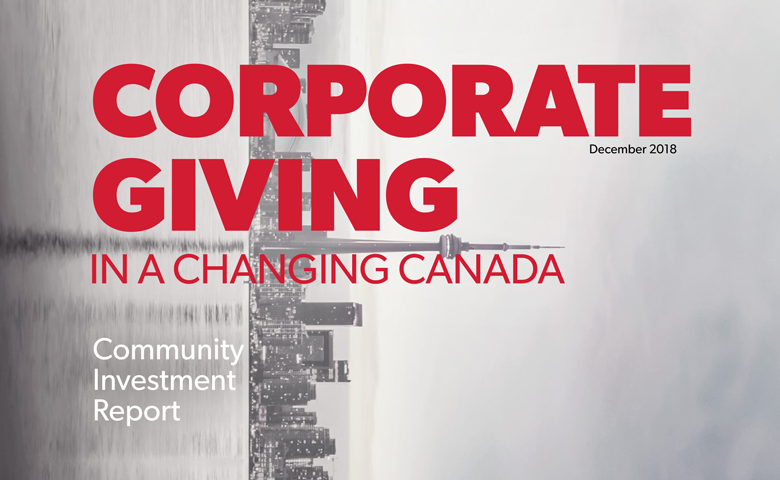- Home
- About Us
- The Team / Contact Us
- Books and Resources
- Privacy Policy
- Nonprofit Employer of Choice Award

 Ten years ago, Imagine Canada released Business Contributions to Community (BCTC). A groundbreaking study, BCTC provided the first-ever comprehensive portrait of business’ charitable contributions in Canada. The survey was the largest of its kind to represent the broad philanthropic behaviour of the business community in Canada.
Ten years ago, Imagine Canada released Business Contributions to Community (BCTC). A groundbreaking study, BCTC provided the first-ever comprehensive portrait of business’ charitable contributions in Canada. The survey was the largest of its kind to represent the broad philanthropic behaviour of the business community in Canada.
The field of community investment has evolved in the years since, thanks to technology-driven shifts in consumer demands, the workplace, and the global environment. A call for evidence-based decision making is changing the nature of giving, replacing impassioned choices with strategic partnerships that also support business goals. Paradoxically, radical shifts in how we connect have increased the need to do more and do it now. Canadians feel compelled to help their neighbour and are mobilized to act in swarms of generosity. The social phenomenon that emerged with the Kony 2012 movement has become business as usual.
Many companies have kept pace, investing in their communities as a means of developing resiliency in this new state of change. They have supported the development of the Canadian workforce, fostered authentic ties with nonprofit partners, and are rethinking the delivery of their value chain.
A recently released report aims to explain how these changes may have affected the state of community investment, and to identify lessons for aspiring companies in the field. We aim to provide policymakers, corporate leaders, and nonprofits with a new understanding of the opportunities for partnership and the characteristics of successful community investment.
The report found several key trends including the importance of integration of investment with strategy, the impact of natural disasters on corporate giving, the deepening of corporate partnerships with fewer organizations, and the increased sophistication of the sector.
COMPANIES THAT INTEGRATE THEIR COMMUNITY INVESTMENT WITHIN THEIR OVERALL BUSINESS STRATEGY REPORTED HIGHER SOCIAL AND BUSINESS IMPACT
Nearly all companies that believed their community investments were also substantially improving their business felt that their community strategy is strongly aligned with their overall business strategy. With this came a clear focus on measurement and key performance indicators, integration of community investment with other departments, and a focus on community consultations to improve impact results.
AS FOREST FIRES, FLOODING, AND OTHER TRAGEDIES STRIKE CANADIAN COMMUNITIES, COMPANIES PLAYED A UBIQUITOUS ROLE IN HELPING RECOVERY
The research shows the vital role that companies play in assisting these communities’ crises responses with a full 84% of the companies surveyed donating cash in response to natural disasters, accidents, and crises, while many also raised money from employees (58%), donated goods or products (30%), or raised money from customers or suppliers (24%). Crises commonly supported included the Fort McMurray Wildfires (65%), the Humboldt community (50%), and the Quebec and Eastern Ontario Floods (33%).
STRATEGIC PARTNERSHIPS WITH SELECT NONPROFITS ARE COMMON, LEADING TO FEWER FUNDS FOR THE REST
78% of respondents had at least one nonprofit they considered to be a strategic partner, and most indicated this was a growing priority. Of those with partnerships, 42% indicated they were funding fewer nonprofits to focus more resources on their signature partners.
OVER THE LAST DECADE, THE COMMUNITY INVESTMENT FIELD HAS BECOME FAR MORE SOPHISTICATED
Ten years ago, when Imagine Canada surveyed companies as part of a previous large-scale study of corporate philanthropy, (Hall, Ayer, Zarinpoush, & Lasby, 2008), only 34% of companies with at least 500 employees had written policies to guide their giving, compared to 95% of similarly sized respondents today. Similarly, 46% more businesses measure the business benefits of their donations now versus then. Companies have become more strategically focused and sophisticated, and this is driving a wide range of changes in community investment practice.
This research is an enormous service to the sector. By providing current information and trends, this research gives charities and business important strategic information.
Corporate Giving in a Changing Canada is the result of a collaborative research initiative, in partnership with other leading organizations in this space, and leverages three primary data sources. Findings examine: the results of a survey completed in 2018 by 54 companies, many of them Imagine Canada Caring Companies; a literature review on the topic of CSR and community investment; and anecdotal examples from leading companies.